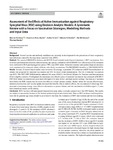Assessment of the Effects of Active Immunisation against Respiratory Syncytial Virus (RSV) using Decision-Analytic Models: A Systematic Review with a Focus on Vaccination Strategies, Modelling Methods and Input Data
Treskova, Marina
Pozo‑Martin, Francisco
Scholz, Stefan
Schönfeld, Viktoria
Wichmann, Ole
Background:
Several vaccine and antibody candidates are currently in development for the prevention of lower respiratory tract infections caused by the respiratory syncytial virus (RSV). Methods:
We searched MEDLINE, Embase, and SCOPUS and included model-based evaluations of RSV vaccinations. Two reviewers performed the selection, data extraction, and quality evaluation with EVIDEM. Cost-effectiveness (CE) estimates were converted to $US purchasing power parity (PPP), year 2018 values. Potential economic and epidemiological outcomes were summarised for maternal, infant, children, and elderly vaccinations. The PROSPERO identifier is CRD42019122570.
Results:
In total, 22 model-based studies were reviewed. On average, a potential 27% reduction in RSV hospitalisations in infants was projected for maternal vaccination and 50% for direct infant immunisation. The CE of maternal vaccination was $US1766–5857 PPP 2018/disability-adjusted life-years (DALYs) for Global Alliance for Vaccines and Immunisation (Gavi)-eligible countries. For England, the maximum cost-effective price of maternal vaccination was estimated at $US81.5 PPP 2018. Infant vaccination was associated with higher CE ratios in low- and high-income settings. Vaccination of neonates born before the RSV season was the most cost effective in high-income settings. Higher values for vaccine effectiveness, duration of protection, and vaccine uptake increased the benefits. Due to indirect effects, the vaccination of school-age children and a cocooning strategy were effective alternatives to protect infants, and the vaccination of children aged < 5 years had a beneficial impact on the elderly.
Conclusion:
RSV vaccines with anticipated characteristics may reduce a sizeable proportion of the RSV burden. The results are subject to uncertainty because of the limited epidemiological and clinical data. Data on RSV incidence and hospitalisation risk for granular age strata should be prioritised to facilitate the evaluation of RSV interventions and decision making.
Dateien zu dieser Publikation

